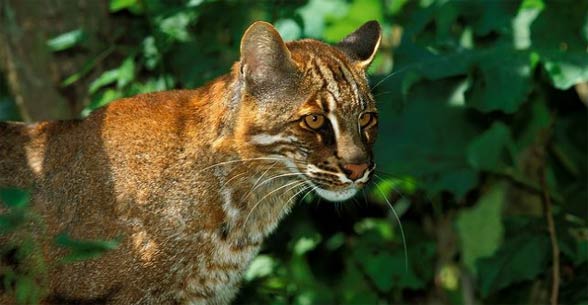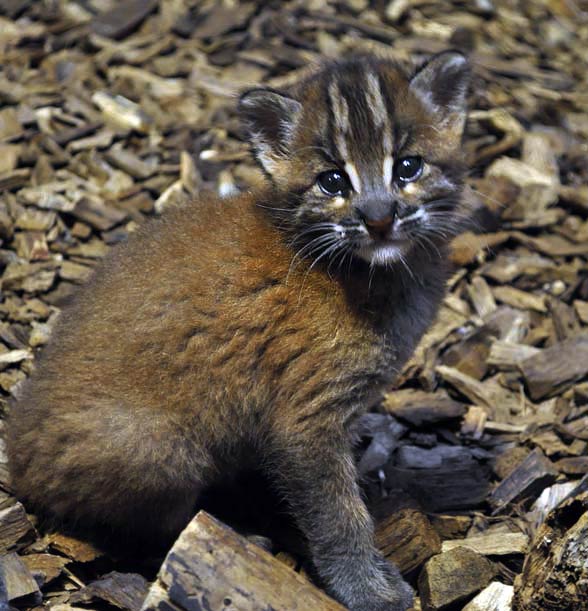Asian golden cat / Asiatic golden cat
This exotic Asian cat with golden fur is an elusive inhabitant of the jungle and other forest formations. Despite its name, the fur of the Asian golden cat has different shades than gold or amber. It is one of the most diverse felids in terms of coloration.
Classification
- Kingdom: Animalia
- Class: Mammalia
- Order: Carnivora
- Family: Felidae
- Genus: Catopuma
- Species: Catopuma temminckii / Pardofelis temminckii
- Names: Asian golden cat, Asiatic golden cat, Temminck’s cat

There have been 3 subspecies classed within the species:
- Pardofelis temminckii temminckii – found in the Himalayas, Southeast Asian mainland and Sumatra
- Pardofelis temminckii tristis – found in south-western China
- Pardofelis temminckii dominicanorum – found in south-eastern China.

Occurrence and habitat
The Asian golden cat is found in countries such as:
- Bhutan
- Burma
- Cambodia
- China
- India
- Laos
- Malaysia
- Nepal
- Sumatra
- Thailand
- Tibet
- Vietnam
For its habitats, it chooses forests with rocky areas, and evergreen forests and deciduous forests. From time to time it is seen in open areas, such as the grasslands of Assam’s Manas National Park in India. In the Himalayas, it occurs at altitudes up to 3,000 m (9,800 ft) above the sea level. In Laos, it is found in bamboo forests and scrub.

Characteristics
Appearance
The Asian golden cat is a relatively big, but not so heavy cat that has a typical appearance for its family. The body length ranges between 66-105 cm (26-41 in), and with the tail it is by 40-57 cm (16-22 in) longer. The height at shoulders is 56 cm (22 in), and weight reaches 9-16 kg (20-35 lb).
Fur and coloration
The coat is uniform in color, but the coloration within the species is very diverse, because there are individuals that are red, golden-brown, pale cinnamon, gray, dark brown, and even black (melanistic individuals). The coat can also be covered with a number of white and black stripes and spots, mostly from the cheeks to the top of the head. The ears are black, and gray in the center.
In China, there are individuals colored almost identically as the Bengal cat (Prionailurus bengalensis). The spotted coat is a recessive feature, therefore, it occurs rather rarely. The undersides and the inside part of the legs are white, and the eyes are green, gray or amber. It has been observed that individuals in the most northern regions have more patterns than other Asian golden cats.

Diet
As all felids, the Asian golden cat prefers meat. It hunts for small ungulates (muntjacs, young sambar deer), big rodents, birds, Amphibians, lizards, and insects. It can also hunt an animal larger than itself, for example, a calf of a water buffalo. In the mountains of the Indian state Sikkim it feeds on gorals and serows.

Lifestyle
The Asian golden cat is a territorial and solitary animal. Probably it’s most active at night, although there are individuals active at dusk, and even at daytime. It has been observed that territories of the Asian golden cat expand along with the rainy season. 15%. The territories of males are always bigger than the females’ ones. The borders are marked with urine, scratches on tree bark and rubbing the head against various objects (domestic cats do the same).
Observations have shown that, the Asian golden cat wanders from only 55 m (180 ft) to 9 km (5.6 mi) daily. Although it can climb trees, it spend the majority of time on the ground.
It also produces plenty of sounds, including hissing, purring, growling, meowing, spitting, or characteristic gurgling.

Reproduction
Little has been known about the reproduction of the Asian golden cat, because this animal is difficult to observe in the wild. The majority of information about this issue comes from the observations of individuals in captivity. Females become sexually mature in the 18-24th month of life, and males after about 24 months. Rooting is every 39 days, and at this time the female leaves scent marks that are to attract a partner.
Gestation is 78-80 days long, and one litter consists of 1-3 kittens. A newborn Asian golden cat weighs 220-250 kg (0,485-0,551 lb), but after 8 weeks the weight increases three times. After 6-12 days a kitten opens its eyes and is covered with “adult” fur after about 6 months it is weaned.

Detailed information / size
Asian golden cat (Pardofelis temminckii)
- Body length without the tail: 66-105 cm (26-41 in)
- Tail length: 40-57 cm (16-22 in)
- Weight: 9-16 kg (20-35 lb)
- Lifespan: to 20 years in captivity

Asian golden cat – interesting facts
- In China the Asian golden cat is called the “rocky cat”.
- The Asian golden cat is 2-3 times heavier than a domestic cat.
- The Asian golden cat is one of the least studied cats of tropical Asia.
- There are fewer than 12 individuals in captivity in the world, of which only 4-5 females litter. In zoos, males often kill females, even those that they know well.
- The Asian golden cat is poached because of its beautiful, thick fur. Between 1991 and 2006 in Burma 111 body parts of at least 110 individuals were found. It means that the Asian golden cat is a treat in illegal trade in wild fauna.
- The Asian golden cat is very similar to the African golden cat (Caracal aurata), but it’s unlikely that both species are closely related, because the forests of Africa and Asia haven’t been connected for 20 million years. This big similarity of these felids may be associated with the phenomenon of convergent evolution.
- In some regions of Thailand, this cat is called Seua fai – “fire tiger”. According to a local legend, burning the fur of an Asian golden cat drives tigers away; eating the meat of an Asian golden cat has reportedly similar results. The Karen (an Asiatic people) believe that it is enough to carry a single hair of an Asian golden cat to protect yourself from a tiger attack.

Recommended
- Persian leopard
- Amur leopard
- Siberian tiger
- Bengal tiger
- Sumatran tiger
- Indochinese tiger
- Malayan tiger
- South China tiger
- Tigers
- White tigers
- Lions
- White lions
- Lion vs tiger
- Liger
- Lynx
- Canada lynx
- Caracal
- Margay
- Jaguarundi
- Serval
- Ocelot
- Animal fights
- American lion
- European cave lion
- Smilodon – Saber-toothed tiger
- Fights of animals
- Big cats
- Black panther
- Leopard
- Snow leopard
- African Lion
- Fastest animals
- Fastest birds


















